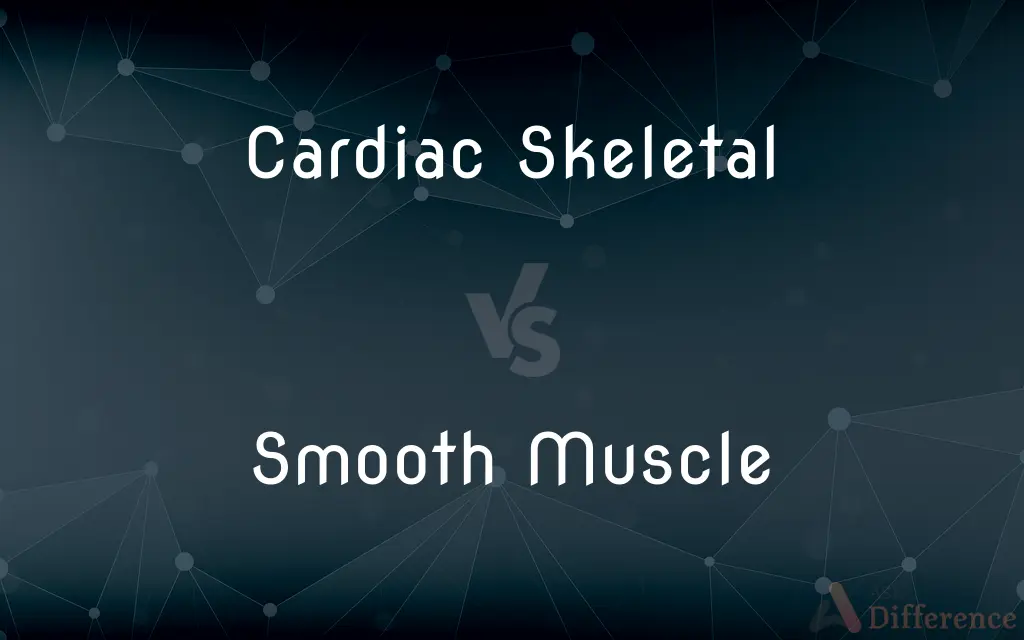Cardiac Skeletal vs. Smooth Muscle — What's the Difference?
Edited by Tayyaba Rehman — By Fiza Rafique — Published on December 14, 2023
Cardiac muscle powers the heart, skeletal muscle enables body movement, and smooth muscle lines internal organs and vessels.

Difference Between Cardiac Skeletal and Smooth Muscle
Table of Contents
ADVERTISEMENT
Key Differences
Cardiac Skeletal muscle is a misnomer, as these are two distinct types; cardiac muscle is found in the heart, whereas skeletal muscle is attached to bones. Smooth muscle, on the other hand, is found in the walls of organs and structures like the stomach, intestines, and blood vessels.
Both Cardiac and skeletal muscles are striated, meaning they show a pattern of light and dark bands when viewed under a microscope. Smooth muscle doesn't have this striated appearance and looks smooth, hence the name.
Cardiac muscle is responsible for pumping blood throughout the body, and it contracts involuntarily. Skeletal muscle allows for voluntary movement like walking or lifting. Smooth muscle, though involuntary like cardiac muscle, manages the constriction and dilation of blood vessels and organ walls.
A significant distinction between cardiac skeletal muscle is their response to stimuli and fatigue. Cardiac muscles are more resilient to fatigue than skeletal muscles. In contrast, smooth muscle contracts slower than both but can sustain contractions longer without tiring.
Finally, when considering regeneration, cardiac muscle cells have a limited ability to repair or regenerate after damage. Skeletal muscles have a better capacity for repair. Smooth muscle can regenerate to some degree, especially when compared to cardiac muscle.
ADVERTISEMENT
Comparison Chart
Appearance
Striated
Non-striated
Control
Involuntary/Voluntary
Involuntary
Location
Heart/Bones
Organs & Blood Vessels
Rate of Fatigue
Resilient/Can fatigue
Sustains longer
Regeneration Ability
Limited/Good
Moderate
Compare with Definitions
Cardiac Skeletal
Relating to the intersection of cardiac and skeletal muscle functions.
Researchers explored Cardiac Skeletal interactions in their latest study.
Smooth Muscle
Non-striated muscle responsible for contractions in internal organs.
Smooth Muscle contractions manage the flow of blood in our vessels.
Cardiac Skeletal
A term highlighting the juxtaposition of heart and skeletal functionalities.
His Cardiac Skeletal disorder was a rare combination of both muscle issues.
Smooth Muscle
Muscle type that appears smooth under the microscope.
Compared to striated muscles, the Smooth Muscle has a distinct appearance.
Cardiac Skeletal
Pertaining to both the heart and the bones.
She studied the Cardiac Skeletal systems to understand the body's movement and circulation.
Smooth Muscle
Involuntary muscle found in the walls of organs and structures.
The stomach's movements are due to the action of Smooth Muscle.
Cardiac Skeletal
Representing combined studies of heart and skeletal muscles.
She specialized in Cardiac Skeletal physiology for a comprehensive understanding.
Smooth Muscle
Slow-contracting muscle with sustained contraction ability.
Smooth Muscle can remain contracted longer, aiding in prolonged organ functions.
Cardiac Skeletal
A reference combining the characteristics of heart and skeletal muscles.
The Cardiac Skeletal diagram helped her discern the distinct muscle types.
Smooth Muscle
Regenerative muscle lining organs like the intestines and bladder.
Injury to the bladder often heals due to the regenerative capacity of Smooth Muscle.
Common Curiosities
Are Cardiac Skeletal muscles striated or non-striated?
Both cardiac and skeletal muscles are striated, while smooth muscle is non-striated.
Do Cardiac Skeletal muscles operate voluntarily or involuntarily?
Cardiac muscle operates involuntarily, while skeletal muscle functions voluntarily.
What appearance does Smooth Muscle have under a microscope?
Smooth muscle appears non-striated or smooth, while cardiac and skeletal muscles appear striated.
Is the contraction of Smooth Muscle faster or slower compared to Cardiac Skeletal muscles?
Smooth muscle contracts slower than both cardiac and skeletal muscles.
What's the primary role of Cardiac Skeletal muscles in movement?
While cardiac muscle ensures blood circulation, skeletal muscle allows for voluntary body movements.
How do Smooth Muscles react in blood vessels?
Smooth muscles manage the constriction and dilation of blood vessels.
What's the main function of Cardiac Skeletal muscles?
Cardiac muscle powers the heart, while skeletal muscle enables body movement.
How do Smooth Muscles aid in the body's regulation?
Smooth muscles help regulate processes like blood flow and digestion due to their involuntary contractions.
Where can you find Smooth Muscle in the body?
Smooth muscle is found in the walls of organs and structures like the stomach, intestines, and blood vessels.
Which muscle type, Cardiac Skeletal or Smooth, regenerates the best?
Skeletal muscle has the best regeneration ability, followed by smooth muscle, with cardiac muscle having limited regeneration.
Can Cardiac Skeletal muscles tire easily?
Skeletal muscles can fatigue with prolonged activity, but cardiac muscles are resilient to fatigue.
How distinct is Smooth Muscle from Cardiac Skeletal muscles in appearance?
Smooth muscle is non-striated, making it distinct from the striated appearance of both cardiac and skeletal muscles.
Can you find Cardiac Skeletal muscles in the same location?
No, cardiac muscle is in the heart, and skeletal muscle is attached to bones.
Do Cardiac Skeletal muscles have similar regenerative abilities?
No, skeletal muscles have a better capacity for repair than cardiac muscles.
Why is Smooth Muscle essential in the digestive process?
Smooth muscle helps propel and mix food in the digestive tract through its contractions.
Share Your Discovery

Previous Comparison
Isotopomer vs. Isotopologue
Next Comparison
Internal Sources of Finance vs. External Sources of FinanceAuthor Spotlight
Written by
Fiza RafiqueFiza Rafique is a skilled content writer at AskDifference.com, where she meticulously refines and enhances written pieces. Drawing from her vast editorial expertise, Fiza ensures clarity, accuracy, and precision in every article. Passionate about language, she continually seeks to elevate the quality of content for readers worldwide.
Edited by
Tayyaba RehmanTayyaba Rehman is a distinguished writer, currently serving as a primary contributor to askdifference.com. As a researcher in semantics and etymology, Tayyaba's passion for the complexity of languages and their distinctions has found a perfect home on the platform. Tayyaba delves into the intricacies of language, distinguishing between commonly confused words and phrases, thereby providing clarity for readers worldwide.












































